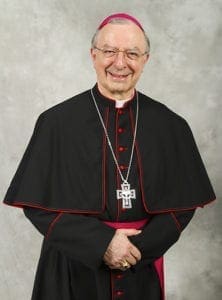Returning to the harbor of truth and unity
By BISHOP JOEL M. KONZEN, SM | Published October 21, 2020 | En Español
Not long ago I was speaking to a prominent bishop, who remarked, “More and more I hear the statements, ‘I don’t agree with the pope’ or ‘I don’t agree with the church,’ and these people are not overly bothered by the fact that they are in disagreement with the church they call their own. It’s simply a statement of fact.” Both of us recalled that it was a sentiment we didn’t hear voiced in our households when we were young.

Bishop Joel M. Konzen, SM
This bishop went on to say that he feared that this was perhaps the primary way that some were relating to the Catholic Church—as critics. We both admitted that there were shortcomings in the Catholic Church that one could and should take issue with, but we hoped that interested, active Catholics would always want to and would in fact “come back to the harbor of truth and unity,” as the Consecration to the Sacred Heart of Jesus prays.
In a church where people relate primarily as critics, what is lost is a sense of unity in which the pope and bishops can truly teach and in which people engage with each other as cooperators seeking to advance the reach of the church’s evangelical mission. Each day in this country, we are exposed to powerful political messages of all stripes. It may be sadly inevitable that, over time, we become wedded to a reality that is rather more political than ecclesiastical, by which the message and the course of the church seem less compelling than the ever-present drama of political pitched battles—to the point that only a pitched battle can make the church similarly captivating.
On the same day as I spoke to the bishop, I heard from a lay member of the local church who wondered how it is that so many Catholics who grasp and are baptized and confirmed in the truth of their faith eventually wander off to other churches or to a life outside the practice of religion. Someone else at the table opined that it’s one thing to be schooled successfully in the doctrine of the faith, but that people, especially young people, must see it backed up by examples of love, welcome, and generosity in order for the teaching to take hold and truly live in the individual Catholic. It was also admitted that some Catholics had not been very thoroughly catechized and might have had a deficient understanding of Catholicism and its sacraments from the beginning.
I suspect that these are trends that prompt questions in many of us. How can we be faithful to, how can we love the church that has been our home, and, at the same time, neither ignore its constant need for reform (semper reformanda) nor fail to work for its wider embrace by present and prospective members? Of course, I have promised in a public liturgy that I will remain loyal to the teachings of the church and to the direction of the Holy Father. But so also everyone else in our church when we renew our baptismal promises. We believe in—that is, we cling to—a church that is one, holy, catholic, and apostolic. And we deserve the occasional reminder of how we might celebrate our unity rather than our division as Catholics.
St. John Paul II issued an encyclical beginning with Jesus’ fervent prayer in his passion, “Ut Unum Sint,” “That All Might be One,” aimed especially at the prospects of uniting Christians of varying traditions. We know, though, that cannot be a viable hope unless this bearer of truth we call the one true church is indeed one and we are agreed that it teaches and seeks to live the truth.